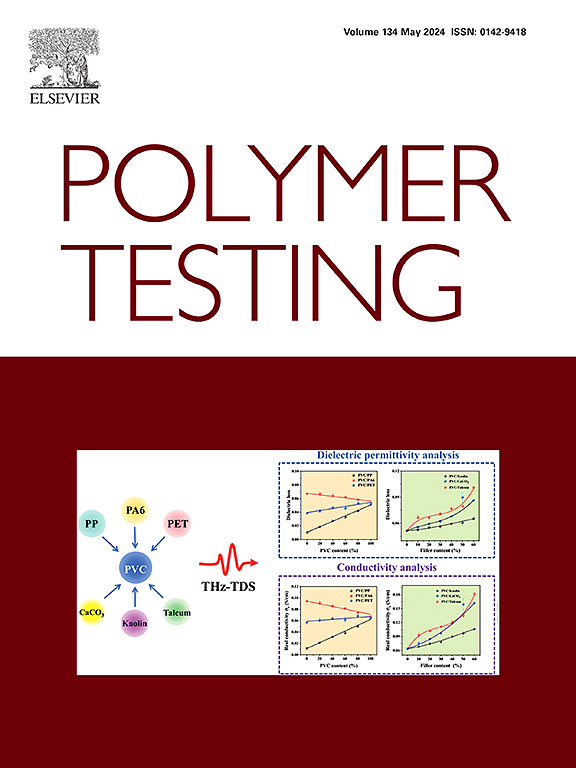Effect of hard segment content on the phase separation and properties of hydroxyl-terminated polybutadiene thermoplastic polyurethane
IF 5
2区 材料科学
Q1 MATERIALS SCIENCE, CHARACTERIZATION & TESTING
引用次数: 0
Abstract
Thermoplastic polyurethane (TPU) possesses a distinctive microphase separation structure resulting from the thermodynamic incompatibility between its soft and hard segments. The content of hard segments is a significant factor that impacts the micromorphology and associated properties of TPU. In this study, hydroxyl-terminated polybutadiene thermoplastic polyurethanes (HTPB-TPUs) were synthesized using a two-step method in which hydroxyl-terminated polybutadiene, toluene diisocyanate, and 1,4-butanediol were incorporated. These HTPB-TPUs were designed to lack hydrogen bonding between the soft and hard segments. The structure and properties of the HTPB-TPUs were comprehensively evaluated. The results demonstrated a noticeable influence of the hard segment content on the degree of microphase separation. A combination of analytical techniques was employed to elucidate the effect of hard segment content on phase separation. Additionally, all-atom molecular dynamics simulations were conducted to determine the number of hydrogen bonds. These simulations served to verify the impact of the hard segment content on phase separation. Furthermore, the relationship between the hard segment content and the mechanical properties was elucidated by examining the phase separation phenomenon. This study provides valuable insights into the interaction between the structure and properties of TPU, laying a foundation for future investigations in this area.
硬段含量对端羟基聚丁二烯热塑性聚氨酯相分离及性能的影响
热塑性聚氨酯(TPU)具有独特的微相分离结构,这是由于其软段和硬段之间的热力学不相容造成的。硬段含量是影响TPU微形貌及相关性能的重要因素。本研究以端羟基聚丁二烯、甲苯二异氰酸酯和1,4-丁二醇为原料,采用两步法合成端羟基聚丁二烯热塑性聚氨酯(htpb - tpu)。这些htpb - tpu被设计成在软段和硬段之间缺乏氢键。对htpb - tpu的结构和性能进行了综合评价。结果表明,硬段含量对微相分离程度有显著影响。结合多种分析技术研究了硬段含量对相分离的影响。此外,还进行了全原子分子动力学模拟,以确定氢键的数量。这些模拟有助于验证硬段含量对相分离的影响。此外,通过对相分离现象的研究,阐明了硬段含量与力学性能之间的关系。本研究为TPU结构与性能之间的相互作用提供了有价值的见解,为该领域的进一步研究奠定了基础。
本文章由计算机程序翻译,如有差异,请以英文原文为准。
求助全文
约1分钟内获得全文
求助全文
来源期刊

Polymer Testing
工程技术-材料科学:表征与测试
CiteScore
10.70
自引率
5.90%
发文量
328
审稿时长
44 days
期刊介绍:
Polymer Testing focuses on the testing, analysis and characterization of polymer materials, including both synthetic and natural or biobased polymers. Novel testing methods and the testing of novel polymeric materials in bulk, solution and dispersion is covered. In addition, we welcome the submission of the testing of polymeric materials for a wide range of applications and industrial products as well as nanoscale characterization.
The scope includes but is not limited to the following main topics:
Novel testing methods and Chemical analysis
• mechanical, thermal, electrical, chemical, imaging, spectroscopy, scattering and rheology
Physical properties and behaviour of novel polymer systems
• nanoscale properties, morphology, transport properties
Degradation and recycling of polymeric materials when combined with novel testing or characterization methods
• degradation, biodegradation, ageing and fire retardancy
Modelling and Simulation work will be only considered when it is linked to new or previously published experimental results.
 求助内容:
求助内容: 应助结果提醒方式:
应助结果提醒方式:


